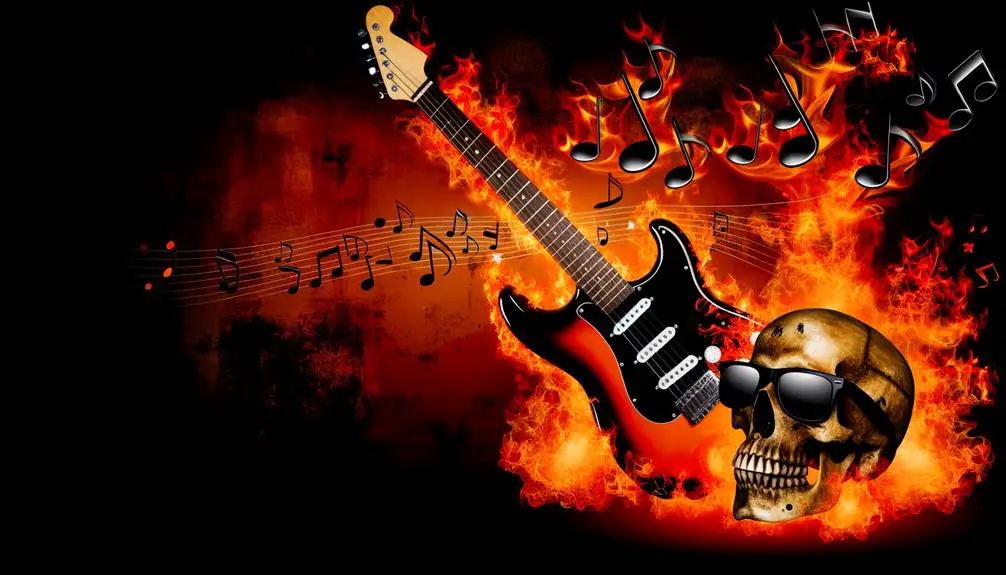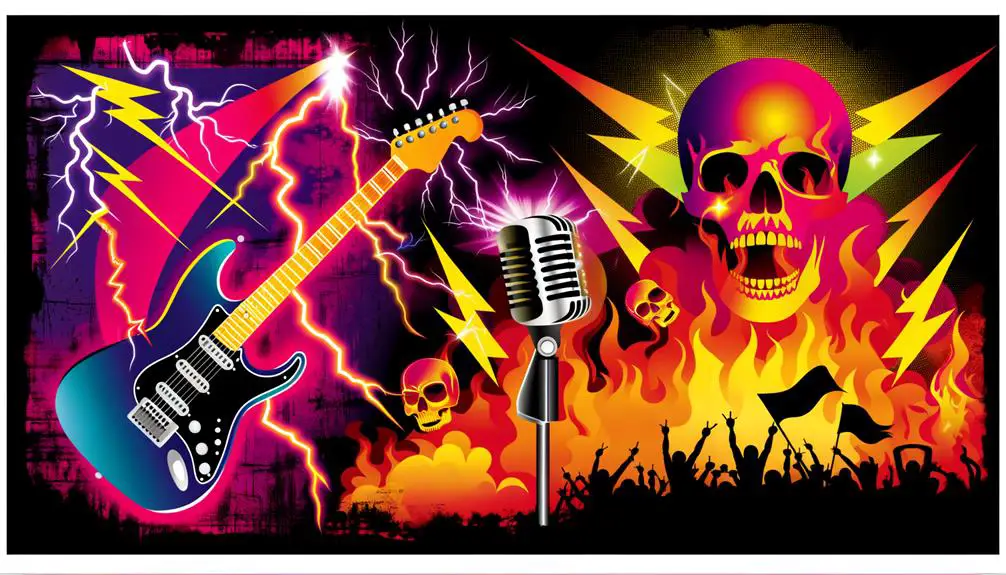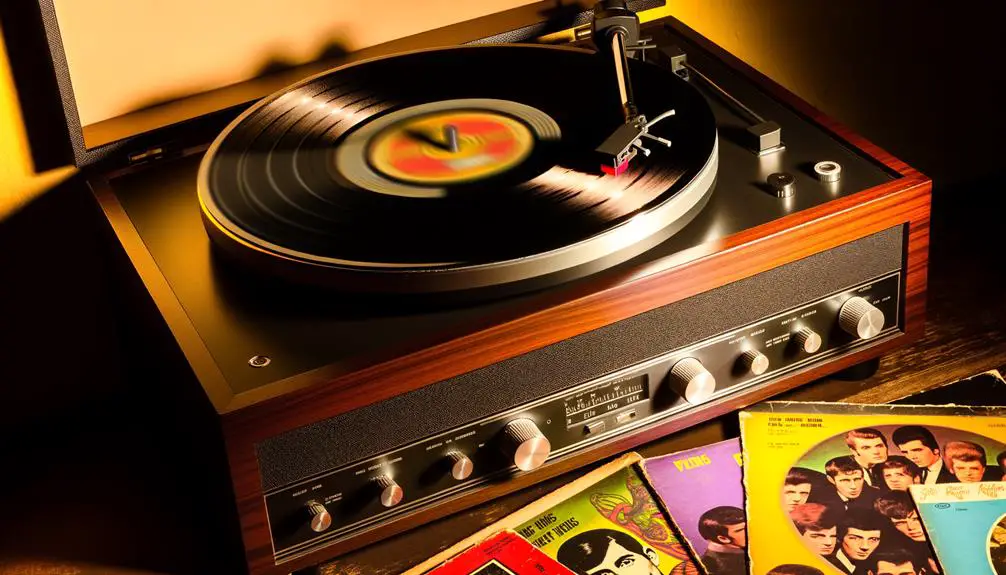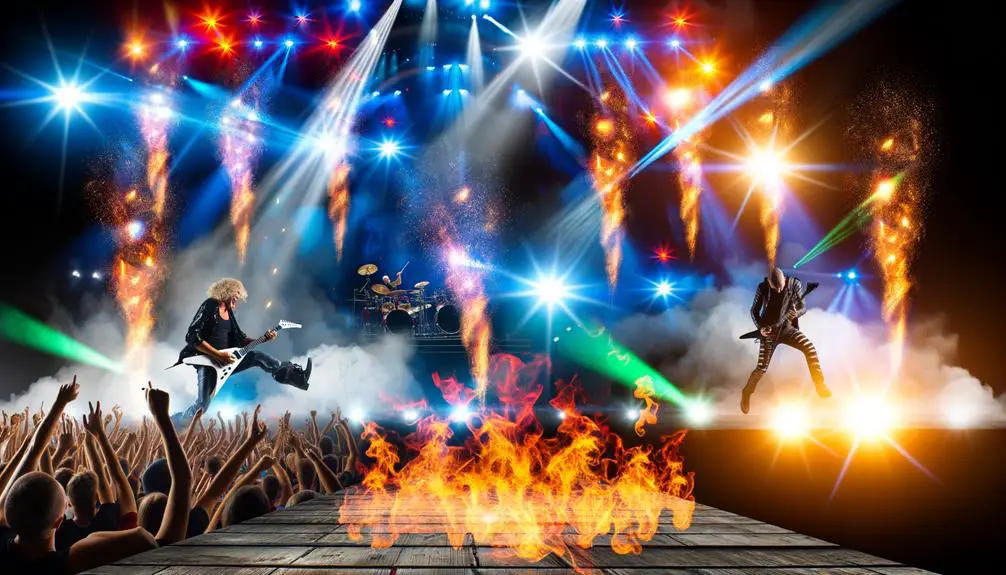What Is the Meaning of the Rock and Roll Hand Symbol?
Rock and roll symbols encapsulate the genre's essence of rebellion, innovation, and identity. The electric guitar symbolizes artistic and technical prowess, while the leather jacket signifies defiance against mainstream norms.
The devil-horns gesture, with its ancient origins, has evolved into a sign of solidarity within rock subcultures. Vocal expressions like the rebel yell emphasize nonconformity and resistance.
Visual elements such as concert posters and band logos not only communicate urgency and defiance but also create cultural touchstones. Stage pyrotechnics and amplifiers enhance the genre's dynamic performances.
Explore the layers of these symbols to fully grasp rock and roll's cultural impact.

Key Takeaways
- The iconic guitar symbolizes innovation, rebellion, and artistic expression in rock and roll.
- The leather jacket represents defiance, attitude, and challenges to mainstream norms.
- The devil-horns gesture signifies rebellion, solidarity, and musical identity within rock and metal subcultures.
- Band logos and emblems serve as visual shorthand for collective identity and countercultural values.
- Vinyl records embody rock's unadulterated sound, historical evolution, and artistic expression.
The Iconic Guitar

Emblematic of the genre's rebellious spirit and innovative drive, the electric guitar has become the quintessential symbol of rock and roll. Its emergence in the mid-20th century catalyzed a musical revolution, fostering unprecedented artistic expression and technical virtuosity.
The electric guitar's amplified sound and distortion capabilities allowed artists to craft unique sonic landscapes, embodying the genre's ethos of defiance and creativity. Iconic figures such as Jimi Hendrix, Eric Clapton, and Jimmy Page utilized the instrument not just as a tool, but as an extension of their artistic identities.
The electric guitar's impact on rock and roll is profound, symbolizing both the genre's historical roots and its ongoing evolution, underlining its status as an enduring cultural artifact.
Leather Jacket Legacy
The leather jacket, an enduring symbol within rock and roll culture, epitomizes both an iconic fashion statement and a representation of rebellion and attitude.
Its adoption by influential musicians has elevated it from mere apparel to a powerful emblem of defiant individuality.
This section examines how the leather jacket's evolution mirrors the broader cultural shifts in rock and roll's history.
Iconic Fashion Statement
Synonymous with rebellion and countercultural identity, the leather jacket has become an enduring symbol within the rock and roll fashion lexicon. Its origins trace back to the early 20th century, initially serving practical purposes for aviators and motorcyclists.
However, its adoption by rock icons like Elvis Presley and later by punk bands such as The Ramones elevated it to a sartorial statement of defiance. The leather jacket's rugged aesthetic, coupled with its association with subversive music genres, epitomizes a deliberate challenge to mainstream norms.
This transformation from utilitarian garment to cultural symbol underscores the jacket's dual role in both personal expression and collective identity within the rock and roll community, cementing its legacy as an icon of resistance and individuality.
Rebellion and Attitude
Few garments encapsulate the essence of rebellion and attitude as profoundly as the leather jacket, a staple within the rock and roll ethos. This iconic piece of attire transcends mere fashion, embodying a defiant spirit that challenges societal norms.
Originating in the 1950s with figures like Marlon Brando and James Dean, the leather jacket quickly became synonymous with youthful dissent. In the domain of rock and roll, it evolved into a symbol of countercultural resistance and raw individualism.
The material's rugged durability and edgy aesthetic resonated with musicians and fans alike, reinforcing a collective identity rooted in rebellion. Therefore, the legacy of the leather jacket within rock and roll signifies more than style; it is a manifesto of enduring nonconformity.
Devil-Horns Gesture

The 'devil-horns' gesture, often linked with rock and metal music, has a complex history that predates its adoption by musicians.
Historically rooted in various cultural and religious backgrounds, the symbol has evolved to embody a sense of defiance and individuality within the rock and roll community.
Understanding its cultural impact requires an exploration of how this gesture shifted from ancient mythological connotations to a contemporary emblem of musical subculture.
Gesture's Historical Origins
Tracing the historical origins of the devil-horns gesture reveals a complex tapestry of cultural and symbolic meanings that predate its association with rock and roll.
This hand sign, often misconstrued as solely a contemporary symbol, has roots in various ancient traditions and practices.
- Mediterranean Cultures: Used to ward off the 'evil eye,' a form of protection against malevolent forces.
- Hindu and Buddhist Iconography: Depicted in several mudras (ritual hand gestures) symbolizing specific spiritual concepts.
- Italian Superstition: Referred to as 'corna,' believed to protect against bad luck or to curse an adversary.
- Occult Practices: Employed in ceremonial magic and witchcraft to indicate different supernatural elements.
This rich historical context underscores the gesture's multifaceted significance across different eras and societies.
Cultural Impact Evolution
As the devil-horns gesture evolved into the world of rock and roll, it underwent a significant transformation, evolving from its ancient protective and mystical connotations to become an emblem of rebellion and musical identity.
Its adoption by iconic figures such as Ronnie James Dio in the late 20th century cemented its status within the rock and heavy metal subcultures. This gesture transcended mere symbolism, encapsulating the anti-establishment ethos and raw energy that characterize these musical genres.
Its widespread usage among fans and artists alike facilitated a sense of community and shared identity, solidifying its place in popular culture. The devil-horns gesture symbolizes not just defiance but also solidarity within the rock and roll community.
Rebel Yell
Often seen as a vocal manifestation of defiance and passion, the 'Rebel Yell' embodies the spirit of rock and roll's rebellious ethos. This auditory expression acts as a strong symbol of nonconformity, resonating with audiences who seek liberation from societal norms. Historically, the 'Rebel Yell' has been used by rock musicians to challenge authority and inspire a collective sense of resistance.
- Authenticity: It conveys a raw, unfiltered expression of individuality.
- Resistance: Represents opposition to traditional standards and restrictions.
- Unity: Fosters a shared sense of identity among fans and artists.
- Catharsis: Provides an emotive release, transforming personal and collective angst into energy.
The 'Rebel Yell' continues to be a powerful emblem of rock and roll's enduring legacy.
Concert Posters

While the 'Rebel Yell' captures the auditory essence of rock and roll, concert posters visually encapsulate the genre's rebellious spirit and cultural impact. These posters serve not just as advertisements, but as cultural artifacts reflecting the era's aesthetic and social dynamics. Often characterized by bold typography, vivid colors, and provocative imagery, they communicate a sense of urgency and defiance.
| Element | Description |
|---|---|
| Typography | Bold, often distorted fonts |
| Color Palette | Bright, contrasting colors |
| Imagery | Symbolic, sometimes controversial |
Concert posters embody the visual lexicon of rock and roll, making them essential to understanding its broader cultural significance. Their design elements contribute to the genre's identity, making them valuable to both fans and scholars.
Band Logos
Band logos serve as both visual signatures and cultural touchstones, evolving from simple designs to intricate works of symbolic art. This transformation reflects broader changes in the music industry and fan engagement, where iconic imagery can encapsulate a band's ethos and legacy.
The analysis of symbolic band emblems therefore provides insight into the interplay between visual identity and musical influence in rock and roll history.
Iconic Imagery Evolution
The evolution of band logos in rock and roll history mirrors not only artistic trends but also the shifting cultural and social dynamics of their respective eras. Band logos serve as visual embodiments of the zeitgeist, often encapsulating the rebellious spirit or avant-garde movements associated with rock music. Additionally, these logos create a tangible connection between the band and its audience, fostering a sense of identity and belonging.
- Cultural Iconography: Logos often incorporate symbols resonant with broader societal movements.
- Artistic Innovation: Shifts in design styles mirror changes in broader art and graphic design trends.
- Commercialization: The shift from underground to mainstream status often leads to logo simplification for brand recognizability.
- Technological Advancements: Evolving printing and digital techniques have continually influenced logo design possibilities.
Symbolic Band Emblems
Examining the symbolic band emblems in rock and roll reveals a rich tapestry of visual elements that convey complex narratives about identity, rebellion, and cultural affiliation. The Rolling Stones' 'Tongue and Lips' logo, for instance, epitomizes countercultural defiance, inspired by Kali, the Hindu goddess of destruction.
Similarly, the Ramones' emblem—a parody of the Presidential Seal—encapsulates their ethos of anti-establishment punk. These logos are not mere marketing tools but cultural signifiers that distill the essence of a band's philosophy and aesthetic.
They serve as visual shorthand for fans, encapsulating shared values and collective identity. By analyzing these emblems, one gains insight into the semiotic power of visual symbols in shaping and sustaining rock and roll's cultural legacy.
Vinyl Records

While the digital age has transformed the music industry, vinyl records remain a potent symbol of rock and roll's enduring legacy and cultural impact. Their physicality and analog nature offer an auditory experience that is both tangible and intimate, contrasting markedly with digital formats.
Vinyl records encapsulate the raw, unfiltered energy of rock music, preserving its authentic essence. Collectors and audiophiles often cite the superior sound quality and tactile engagement as reasons for vinyl's resurgence. Moreover, the album artwork and liner notes add a visual and textual dimension that enriches the listener's connection to the music.
- Authenticity: Vinyl records convey the unadulterated sound of rock and roll.
- Tactile Experience: Handling and playing vinyl engages listeners physically and emotionally.
- Cultural Artifact: They serve as historical records of rock's evolution.
- Artistic Value: Album art and liner notes provide additional layers of artistic expression.
Distinctive Hairstyles
Distinctive hairstyles have long served as a powerful form of self-expression and identity within the rock and roll subculture. These hairstyles, ranging from the rebellious long locks of the 1960s counterculture to the spiked and dyed mohawks of the punk movement, function as visual markers of ideological and aesthetic affiliations.
The rock and roll hairstyle is not merely a fashion statement; it symbolizes defiance against societal norms and an embrace of individualism. In scholarly terms, these coiffures act as semiotic tools that communicate non-verbal messages about the wearer's alignment with particular subcultural values.
Hence, hairstyles in rock and roll become an essential element of the performative and visual lexicon, reinforcing the genre's broader themes of resistance and identity formation.
Stage Pyrotechnics

Just as distinctive hairstyles serve as visual markers of identity within rock and roll, stage pyrotechnics amplify the performative spectacle, embodying the genre's penchant for dramatic and visceral experiences. These fiery displays are not mere embellishments but integral elements that heighten the sensory immersion of live performances.
- Symbolism of Power: Pyrotechnics evoke a sense of dominance and energy, reinforcing the powerful aura that rock musicians project.
- Audience Engagement: The explosive visuals captivate and invigorate the audience, creating a memorable, shared experience.
- Technological Mastery: The use of sophisticated pyrotechnic technology underscores the genre's alignment with innovation.
- Historical Continuity: Rooted in the theatrical traditions of rock, pyrotechnics connect contemporary performances to their historical antecedents.
In essence, stage pyrotechnics are emblematic of rock's dynamic and rebellious spirit.
Amplifiers and Sound
Amplifiers and sound systems form the backbone of rock and roll, transforming the raw energy of electric instruments into powerful auditory experiences that define the genre.
The evolution of amplifier technology, from early tube amplifiers to modern solid-state systems, has greatly shaped the tonal palette of rock music. Amplifiers not only amplify sound but also color it, adding distinct textures and harmonics.
Additionally, the feedback loop—a hallmark in rock—relies on the interaction between amplifiers and guitars. Sound systems, comprising mixers, speakers, and effects processors, further enhance this dynamic.
Rock Star Fashion

Although often perceived as mere aesthetic choices, rock star fashion serves as a potent cultural signifier, reflecting the genre's ethos, historical context, and the individual identities of its icons.
From leather jackets to flamboyant stage costumes, these sartorial elements encapsulate rebellion, nonconformity, and self-expression. The significance of rock star fashion transcends mere appearance, offering insights into societal shifts and subcultural movements.
- Leather Jackets: Symbolize rebellion and a rugged individualism.
- Flamboyant Stage Costumes: Reflect an era's theatricality and the breaking of gender norms.
- Distressed Denim: Embodies authenticity and an anti-establishment stance.
- Band T-shirts: Serve as both fan allegiance and a grassroots marketing tool.
In essence, rock star fashion is a complex tapestry interwoven with cultural, social, and historical threads.
Conclusion
Coincidentally, the confluence of iconic guitars, leather jackets, devil-horns gestures, and rebel yells encapsulates the essence of rock and roll.
Concert posters, distinctive hairstyles, stage pyrotechnics, amplifiers, and sound systems further solidify this cultural phenomenon.
Examining rock star fashion reveals an intricate tapestry of stylistic choices that transcend mere aesthetics, influencing broader cultural movements.
The symbols of rock and roll, through their interconnectedness, collectively establish a powerful, enduring legacy within the annals of music history.






